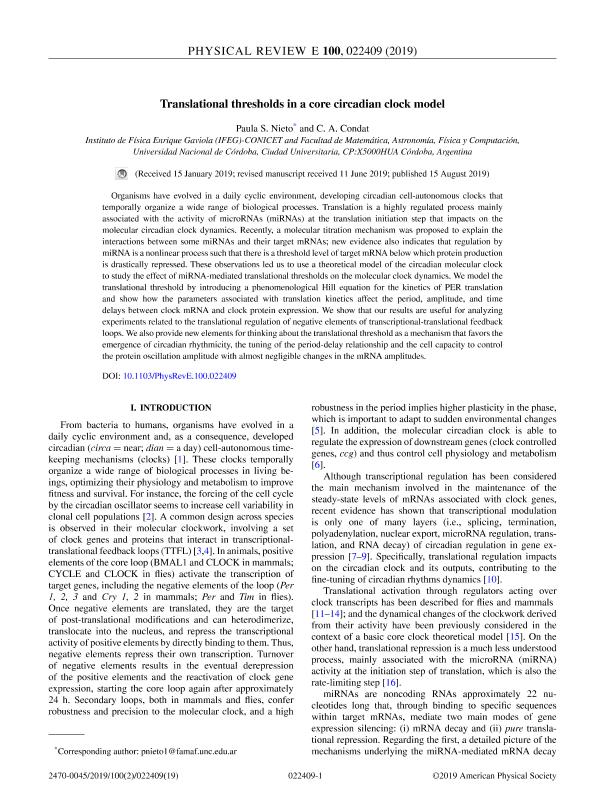Mostrar el registro sencillo del ítem
dc.contributor.author
Nieto, Paula Sofia

dc.contributor.author
Condat, Carlos

dc.date.available
2021-01-29T20:40:39Z
dc.date.issued
2019-08
dc.identifier.citation
Nieto, Paula Sofia; Condat, Carlos; Translational thresholds in a core circadian clock model; American Physical Society; Physical Review E: covering statistical, nonlinear, biological, and soft matter physics; 100; 2; 8-2019; 1-19; 022409
dc.identifier.issn
2470-0045
dc.identifier.uri
http://hdl.handle.net/11336/124290
dc.description.abstract
Organisms have evolved in a daily cyclic environment, developing circadian cell-autonomous clocks that temporally organize a wide range of biological processes. Translation is a highly regulated process mainly associated with the activity of microRNAs (miRNAs) at the translation initiation step that impacts on the molecular circadian clock dynamics. Recently, a molecular titration mechanism was proposed to explain the interactions between some miRNAs and their target mRNAs; new evidence also indicates that regulation by miRNA is a nonlinear process such that there is a threshold level of target mRNA below which protein production is drastically repressed. These observations led us to use a theoretical model of the circadian molecular clock to study the effect of miRNA-mediated translational thresholds on the molecular clock dynamics. We model the translational threshold by introducing a phenomenological Hill equation for the kinetics of PER translation and show how the parameters associated with translation kinetics affect the period, amplitude, and time delays between clock mRNA and clock protein expression. We show that our results are useful for analyzing experiments related to the translational regulation of negative elements of transcriptional-translational feedback loops. We also provide new elements for thinking about the translational threshold as a mechanism that favors the emergence of circadian rhythmicity, the tuning of the period-delay relationship and the cell capacity to control the protein oscillation amplitude with almost negligible changes in the mRNA amplitudes.
dc.format
application/pdf
dc.language.iso
eng
dc.publisher
American Physical Society

dc.rights
info:eu-repo/semantics/openAccess
dc.rights.uri
https://creativecommons.org/licenses/by-nc-sa/2.5/ar/
dc.subject
CIRCADIAN RHYTHMS
dc.subject
GENE EXPRESSION
dc.subject
BIOLOGICAL PHYSICS
dc.subject
REGULATION OF TRANSLATION
dc.subject.classification
Biología

dc.subject.classification
Ciencias Biológicas

dc.subject.classification
CIENCIAS NATURALES Y EXACTAS

dc.title
Translational thresholds in a core circadian clock model
dc.type
info:eu-repo/semantics/article
dc.type
info:ar-repo/semantics/artículo
dc.type
info:eu-repo/semantics/publishedVersion
dc.date.updated
2020-11-19T21:25:58Z
dc.identifier.eissn
2470-0053
dc.journal.volume
100
dc.journal.number
2
dc.journal.pagination
1-19; 022409
dc.journal.pais
Estados Unidos

dc.journal.ciudad
Maryland
dc.description.fil
Fil: Nieto, Paula Sofia. Consejo Nacional de Investigaciones Científicas y Técnicas. Centro Científico Tecnológico Conicet - Córdoba. Instituto de Física Enrique Gaviola. Universidad Nacional de Córdoba. Instituto de Física Enrique Gaviola; Argentina. Universidad Nacional de Córdoba. Facultad de Matemática, Astronomía y Física; Argentina
dc.description.fil
Fil: Condat, Carlos. Consejo Nacional de Investigaciones Científicas y Técnicas. Centro Científico Tecnológico Conicet - Córdoba. Instituto de Física Enrique Gaviola. Universidad Nacional de Córdoba. Instituto de Física Enrique Gaviola; Argentina. Universidad Nacional de Córdoba. Facultad de Matemática, Astronomía y Física; Argentina
dc.journal.title
Physical Review E: covering statistical, nonlinear, biological, and soft matter physics
dc.relation.alternativeid
info:eu-repo/semantics/altIdentifier/url/https://journals.aps.org/pre/pdf/10.1103/PhysRevE.100.022409
dc.relation.alternativeid
info:eu-repo/semantics/altIdentifier/doi/http://dx.doi.org/10.1103/PhysRevE.100.022409
Archivos asociados
